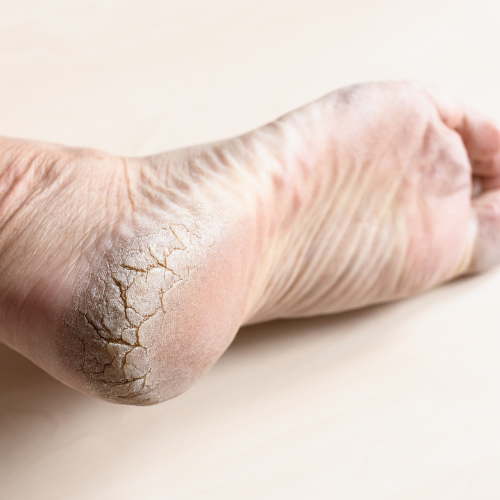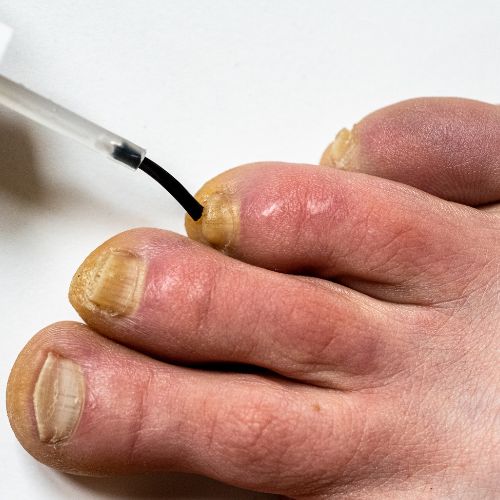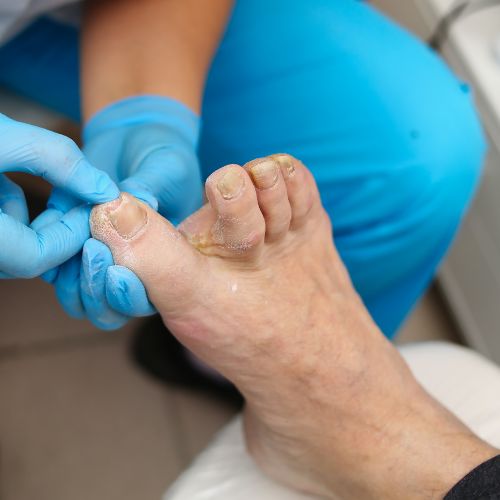Common Foot Conditions
Here are some of the common foot conditions and that can be treated at Farma Footcare.

Calluses
Calluses are diffused areas of thickened hard skin, and may have corns beneath. They usually appear hard and yellow and can cause a burning sensation and generalised discomfort. Calluses are most often found on the ball of the foot and around the edges of the heels, and sometimes on the ends and tops of the toes.
Callus formation is a normal process. Callus can form and disappear without causing any bother. However excessive callus build up can be uncomfortable and for some people very painful.
Areas of callus on the foot can be a sign that there is excessive force to the area of skin involved. This may be due to tight fitting shoes, an abnormality of the bone structure or walking pattern (gait).
Calluses may be mistaken for corns. Unlike corns., causes have no nucleus, pressing on the nerve. Pain from calluses tends to be a wide spread burning sensation rather than the intense pain of a corn.
Corns
Corns are usually a small circular area of thickened hard skin, that may appear yellow or white in colour. They can occur on the ball of the foot, the heels or most often on the toes. There are a few types of corn commonly seen on the foot: hard corns, soft corns, and seed corns.
Corns are usually due to abnormal pressure producing hard skin and a specific area. Over time the hard skin forms into a central hard area also known as a nucleus that digs down onto the skin beneath, causing pain and discomfort.
Pressure can be caused by poorly fitting footwear or due to foot and bone structure.
An abnormality of structure or in the way the foot functions when you walk can create excess abnormal pressures causing a corn to form.


Cracked (Fissured) heels
Cracked or Fissured heels occur when there is a build up of hard skin or callous at the edge of the heels. Callus around the heels tends to become so hard that it splits, causing the heels to appear cracked. Sometimes the cracks are so deep that they can bleed and can become very painful.
Wearing shoes without any backs such as flip-flops or sandals can allow the skin around the heels to spread further which will increase the likelihood of splits in the skin, especially when there is already a build up of callus or dry skin.
Athlete’s foot
Athletes foot is a fungal condition which easily spread between the toes and other parts of the Foot. It can be extremely irritating and itchy, as well as very contagious.
The fungi that cause the infection thrive in warm, dark and moist places like feet, and socks and shoes. Athletes foot can be easily spread to other people by touching infected skin or coming into contact with infected surfaces or objects.
It is not usually serious, but should be treated to stop it spreading to other parts of the body or other people


Fungal nails
A fungus is an organism that can cause infection in the skin and nails.
When a nail is infected by a fungus, the nail will often change colour at the site of the infection and can appear white, yellow or brown. A fungal infected nail may also
become thick, brittle may and begin to split. It is usual for a fungal infection to start in one nail, however, it can easily spread to other nails.
Most fungal nail infections occur as a result of the fungi that cause athlete’s foot infecting the nails. This fungi prefer warm, moist and dark places like the Feet. Another cause can be due to trauma to the nail
Ingrown Toenails
An ingrown toenail is a nail that digs into the flesh at the edge of the nail. The big toe is most commonly affected however, any toenail can become ingrown.
An ingrown toenail is usually painful when the flesh around the toenail is touched. As it progresses the total throb and become very pain.. the flesh around the nail may become inflamed (hot, red and swollen) and you may notice discharge from the area. Ingrown toenails can often become infected.
Ingrown toenails can be caused by:
- An abnormal shaped nail where there is excessive curvature that can cause the nail edges to dig in. This is also known as an involuted nail.
- Abnormal or excess pressure from shoes that are too narrow around the toes, or too high, causing the toes to be pushed forward.
- Trauma to the toe or foot.
- Poor nail cutting.


Verrucae
Verrucae are infectious warts on the feet caused by the human papilloma virus (HPV).
Verrucae may appear in various shapes and sizes . Verrucae are often painful due to their location as they commonly occur on areas of pressure on the feet, like the heels and the ball of the feet.
Verrucae can be round or oval in shape, can be firm and raised or flattened. The surface is irregular and typically like that of a cauliflower. There are often black dots that are actually the blood vessels lying underneath. When scratched verrucae can bleed.
The virus thrives in moist and warm conditions, which is why they are easily caught in and around swimming pools or changing rooms. Verrucae can spread between by walking barefoot in these areas. They can also spread due to scratching by breaking the wart and releasing the spread of the virus to other areas..
Verrucae don’t always hurt but if they grow on weight-bearing areas of the feet, they can be tender and painful when standing or walking.
The length of time it takes for verrucae to disappear will vary from person to person. They tend to last longer in all the children and adults.
Verrucae are less likely to clear up on their own, or respond well to treatment in those with a weakened immune system.
Treatments include cryotherapy and the use of caustics and other chemical compounds that break down the warty tissue overlying the verrucae.
Plantar Fasciitis
Plantar fasciitis is one of the most common causes of heel pain.
The plantar fascia is a tough and flexible band of connective tissue that runs under the sole of the foot, connecting the heel bone with the rest of the bones in the foot acting as a shock absorber.
Plantar fasciitis is the inflammation of this plantar fascia. This can occur suddenly, or gradually over a number of months and years. Tiny tears develop inside the tissue building up a thick layer causing intense pain in the heel and/or arch area of the foot. This pain is most commonly felt first thing in the morning or after long periods of rest.


Diabetes
Diabetes (diabetes mellitus) is a common disease in which blood sugar levels are higher than they should be. Blood sugar levels are regulated by the release of the hormone insulin. People who suffer with diabetes either don’t produce enough insulin, or the body is resistant to the effects of insulin.
Diabetics have an increased risk of ulcers and damage to their feet, so regular diabetic Podiatry is important for overall health and well-being. Simple Foot problems can
escalate very quickly into more serious issues.. It is therefore vital to get any problems attended to immediately.
People with diabetes need to take extra care of their feet and should have them checked by a HCPC registered Podiatrist every 6 to 12 months.
